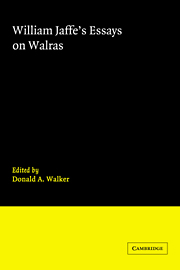Book contents
- Frontmatter
- Contents
- Preface
- Acknowledgments
- Introduction
- PART I WALRAS'S BIOGRAPHY
- PART II THE GENESIS AND DEVELOPMENT OF WALRAS'S IDEAS
- PART III THE SCOPE OF WALRAS'S WORK
- PART IV SPECIAL TOPICS IN WALRAS'S ECONOMICS
- 9 Léon Walras' theory of capital accumulation (1942)
- 10 Walras's theory of capital formation in the framework of his theory of general equilibrium (1953)
- 11 New light on an old quarrel: Barone's unpublished review of Wicksteed's “Essay on the coordination of the laws of distribution” and related documents (1964)
- 12 The Walras-Poincaré correspondence on the cardinal measurability of utility (1977)
- 13 Walras' theory of tâtonnement: a critique of recent interpretations (1967)
- 14 Another look at Léon Walras's theory of tâtonnement (1981)
- PART V WALRAS'S PLACE IN THE HISTORY OF ECONOMIC THOUGHT
- Index
9 - Léon Walras' theory of capital accumulation (1942)
Published online by Cambridge University Press: 05 May 2010
- Frontmatter
- Contents
- Preface
- Acknowledgments
- Introduction
- PART I WALRAS'S BIOGRAPHY
- PART II THE GENESIS AND DEVELOPMENT OF WALRAS'S IDEAS
- PART III THE SCOPE OF WALRAS'S WORK
- PART IV SPECIAL TOPICS IN WALRAS'S ECONOMICS
- 9 Léon Walras' theory of capital accumulation (1942)
- 10 Walras's theory of capital formation in the framework of his theory of general equilibrium (1953)
- 11 New light on an old quarrel: Barone's unpublished review of Wicksteed's “Essay on the coordination of the laws of distribution” and related documents (1964)
- 12 The Walras-Poincaré correspondence on the cardinal measurability of utility (1977)
- 13 Walras' theory of tâtonnement: a critique of recent interpretations (1967)
- 14 Another look at Léon Walras's theory of tâtonnement (1981)
- PART V WALRAS'S PLACE IN THE HISTORY OF ECONOMIC THOUGHT
- Index
Summary
The object of this paper is to expound a much-neglected chapter in the history of economic theory. Special interest attaches itself at present to Léon Walras' discussions of capital, interest, and money because of the affinities which Marget and Lange have shown to exist between these older Walrasian theories and their independently discovered Keynesian counterparts.
What Walras actually had to say about capital accumulation is very difficult to grasp. Part of the difficulty arises from the way in which this particular discussion was incorporated into the whole structure of general static equilibrium. But even more troublesome are the obscurities and lacunae of the discussion itself.
Walras arrives at his theory of capital accumulation as follows. First he develops a pure theory of exchange, which bears a remarkable resemblance in essence to Marshall's “Temporary Equilibrium of Demand and Supply.” In this part of Walras' treatise the stocks of exchangeable commodities are held constant. Then follows the pure theory of production, which corresponds approximately to Marshall's “Equilibrium of Normal Demand and Supply” in the short period. Here the commodities of the former part are viewed as products, and their quantities are subject to variations; but the quantities of productive services and, consequently, of the capital goods yielding productive services are assumed constant. It is not until we arrive at the part entitled “Théorie de la capitalisation et du credit” that the assumption of fixed quantities of capital goods and services is dropped.
- Type
- Chapter
- Information
- William Jaffe's Essays on Walras , pp. 139 - 150Publisher: Cambridge University PressPrint publication year: 1983



